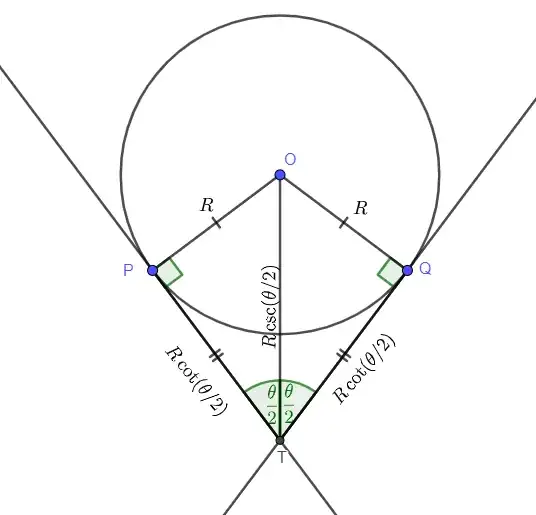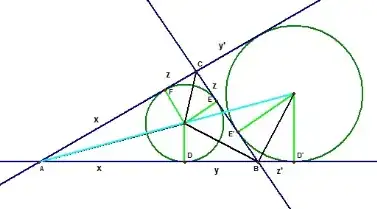The incircle divides $BC$ in the ratio between the cotangents of half the triangle's interior angles at $B$ and $C$, while the excircle opposite $A$ divides $BC$ in the ratio of the cotangents of half the exterior angles there. But interior and exterior angles are supplementary, so their half-angles are complementary, and the cotangents of a half-interior and half-exterior angle must be reciprocals of each other. This is why the incircle and excircle divide $BC$ in the reverse ratio of each other.
To unpack that: the points of contact with the incircle (at $E$) and the excircle (at $E'$) divide the line $BC$ in the reverse ratio to each other; that is, $BE=CE'$, $CE'=BE$, so that the points $E$ and $E'$ are mirror images across the midpoint of $BC$. This gets you what you want since the circle theorem "tangents from a point are equal" tells you that $y'=CE'=BE=BD=y$ and $z'=BE'=CE=CF=z$.
We need two preliminary facts: the tan of a complementary angle is the reciprocal of the tan of that angle (so $\tan(90°-x)$, often written as the cotangent, $\cot(x)$, equals $1/\tan(x)$; replace $90°$ by $\pi/2$ if you know radian measure); and if two tangents to a circle of radius $R$ meet at an angle $\theta$ then the length of those tangents is $R \cot(\theta/2)$ (proof given below).
So for example $BE$ and $BD$ are tangents to the incircle (radius $r$) which meet at angle $\angle ABC$ so have length $y = r \cot (\angle ABC/2)$. Similarly $CE$ and $CF$ are tangents of length $z = r \cot(\angle BCA/2)$. Hence $E$ divides $BC$ in the ratio $$BE:EC = y:z = r \cot (\angle ABC/2): r \cot(\angle BCA/2)$$
We can cancel $r$ and use the trig identity $\cot(x)=1/\tan(x)$ to obtain
$$y:z = \frac{1}{\tan (\angle ABC/2)}: \frac{1}{\tan(\angle BCA/2)} = \tan(\angle BCA/2) : \tan (\angle ABC/2) $$
On the other hand, $BE'$ is a tangent to the excircle (radius $r'$) that meets another tangent of the same length $z'$ at the exterior angle at $B$, which is $180° - \angle ABC$. Therefore $$z' = r' \cot\left(\frac{180° - \angle ABC}{2}\right)=r' \cot(90° - \angle ABC/2) = r' \tan(\angle ABC/2)$$
where we used the complementary angle identity for $\cot$. Similarly $CE'$ has length $y'= r' \tan(\angle BCA/2)$, so by cancelling $r'$ we see $E'$ divides $BC$ in the ratio
$$BE':E'C = z':y' = \tan (\angle ABC/2) : \tan(\angle BCA/2)$$
Hence $E$ divides $BC$ in the reverse ratio to $E'$ and we must have $z=z'$ and $y=y'$.
Proof for length of two tangents meeting at angle $\theta$:

Let $P$ and $Q$ be points on a circle of centre $O$ and radius $R$, and tangents $PT$ and $QT$ meet at an angle $\angle PTQ = \theta$. Then triangles $\triangle OPT$ and $\triangle OQT$ are congruent by RHS since they have right-angles at $\angle OPT$ and $\angle OQT$ (radius is perpendicular to tangent), a common hypotenuse $OT$, and equal legs $OP=OQ=R$. Therefore angles $\angle OTP$ and $\angle OTQ$ must be equal, but they sum to $\theta$ so both must be $\theta/2$. Applying basic trigonometry to $\triangle OPT$ we have
$$\tan(\theta/2) = \frac{R}{PT} \implies PT = \frac{R}{\tan(\theta/2)} = R \cot(\theta/2)$$
and we can also find the length $OT$,
$$\sin(\theta/2) = \frac{R}{OT} \implies OT = \frac{R}{\sin(\theta/2)} = R \csc(\theta/2)$$
The above proof also establishes that the centre of the circle lies on the angle bisector, a fact we use a lot in incircle/excircle questions. See e.g. this geometric proof of $xyz = r^2(x+y+x)$, based on constructing a rectangle composed of right-angled triangles similar to those formed by the tangents to the incircle as in the construction above.

